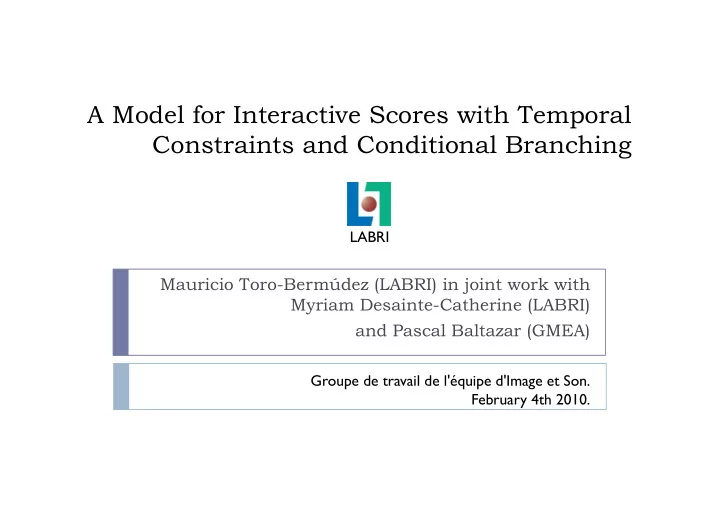

A Model for Interactive Scores with Temporal Constraints and Conditional Branching LABRI Mauricio Toro-Bermúdez (LABRI) in joint work with Myriam Desainte-Catherine (LABRI) and Pascal Baltazar (GMEA) Groupe de travail de l'équipe d'Image et Son. February 4th 2010.
MOTIVATION: INTERACTIVE SCORES Interactive scores (IS) are a formalism for composition and performance of musical pieces where the scores are represented by temporal objects, temporal relations and discrete interactive events. An example of an interactive score with temporal relations A Model for Interactive Scores with Temporal Constraints and Conditional Branching
MOTIVATION: APPLICATIONS IS may be used to compose and perform Electro-acoustic music [1]. To control image, video, audio and lights on live spectacles and interactive museums [2]. In the future, to help handicapped and beginner musicians to perform a difficult piece. A Model for Interactive Scores with Temporal Constraints and Conditional Branching
MOTIVATION: COND. BRANCHING Current IS model [1] does not allow to represent simultaneously conditional branching and temporal relations. Conditional branching is used in programming to model control structures like if/else and switch/case . A Model for Interactive Scores with Temporal Constraints and Conditional Branching
MOTIVATION: COND. BRANCHING Using conditional branching in a IS, a composer can model loops, concurrent execution of multiple instances of a temporal object, and choices. The musician can control, during performance, the choices based on the freedom specified by the composer in the score. A Model for Interactive Scores with Temporal Constraints and Conditional Branching
MOTIVATION: EXAMPLES An infinite loop A non-deterministic choice A Model for Interactive Scores with Temporal Constraints and Conditional Branching
THE PROBLEM Current model [1] represents conditional branching and TRs separately, but there is not an unified way to represent conditional branching, hierarchy, and quantitative and qualitative TRs in the same score. Qualitative TRs are based on Allen’s relations. Quantitative TRs are based on an explicit duration. ? A Model for Interactive Scores with Temporal Constraints and Conditional Branching
BACKGROUND Allen’s relations. Allombert et al.’s model. A Model for Interactive Scores with Temporal Constraints and Conditional Branching
ALLEN’S RELATIONS Schematic representation of Allen’s relations A Model for Interactive Scores with Temporal Constraints and Conditional Branching
ALLOMBERT AT AL.’S MODEL [1] Temporal constraints used to represent some Allen’s relations on [1]: Allen relation T emporal constraint A meet B End(A) = Start(B) A starts B Start(A) = Start(B) A finishes B End(A) = End(B) A Model for Interactive Scores with Temporal Constraints and Conditional Branching
ALLOMBERT AT AL.’S MODEL [1] Temporal objects can be classified by duration: flexible, rigid and semi-rigid. A Model for Interactive Scores with Temporal Constraints and Conditional Branching
SOLUTION An example. Encoding Allombert et al.’s model into ours. Handling multiple instances of a Temporal Object. Limitations. A Model for Interactive Scores with Temporal Constraints and Conditional Branching
SOLUTION: EXAMPLE Our model is based on the concept of points. A point describes the set of the dates when it can be executed. A unless finish d=0 when finish when true d=1 ∆ B = 3 ∆ C = 4 B C when d=0 d=0 true The before relation is the only type of relation. In our model, we only consider flexible durations. A Model for Interactive Scores with Temporal Constraints and Conditional Branching
SOLUTION: ENCODING ALLEN’S RELS. meets A B A B when true duration = 0 before A B A B when true duration > 0 finishes when true A B A B duration = 0 during when true duration > 0 A B A B when true duration > 0 A Model for Interactive Scores with Temporal Constraints and Conditional Branching
SOLUTION : MULTIPLE INSTANCES Executing multiple instances concurrently. 1. Splitting them 2. Delaying them. 3. Cancelling them. 4. Allowing them. Delay A Another instance of A Split A Another instance of A A Cancel A A Allow Another instance of A time A Model for Interactive Scores with Temporal Constraints and Conditional Branching
SOLUTION: LIMITATIONS If we have rigid (or semi-rigid) durations and conditional branching, we cannot have temporal reductions. Even without branching, we cannot have temporal relations and rigid intervals because conditions themselves are choices. A Model for Interactive Scores with Temporal Constraints and Conditional Branching
SOLUTION: LIMITATION EXAMPLE Choice, rigid and semi-rigid durations, and conditional branching. A Model for Interactive Scores with Temporal Constraints and Conditional Branching
STUDY CASE: MARIONA[4] Trans-hierarchical jumps. Loops. Choice. Random duration. A Model for Interactive Scores with Temporal Constraints and Conditional Branching
MARIONA: THE SCORE A Model for Interactive Scores with Temporal Constraints and Conditional Branching
MARIONA: THE SCORE A Model for Interactive Scores with Temporal Constraints and Conditional Branching
SUMMARY & CONCLUSIONS Adding conditional branching to Allombert's model for flexible durations preserving its properties. Including conditional branching limits the expressiveness of temporal relations (e.g., conflicts with the reductions). Whether we can represent all the TRs available in Allombert et al.’s model into ours, or it will be necessary to choose between a timed conditional branching model and a pure temporal model before writing a score, still remains as an open question. A Model for Interactive Scores with Temporal Constraints and Conditional Branching
FUTURE WORK To have rigid and semi-rigid durations on our model. To model random durations (once we have modeled rigid durations). To add probabilities to the choices. To execute the model. A Model for Interactive Scores with Temporal Constraints and Conditional Branching
BIBLIOGRAPHY [1] A. Allombert. Aspects Temporels d'un Système de Partitions Numériques Interactives pour la Composition et l'Interpretation. Ph.D Thesis. Université de Bordeaux 1. 2009. [2] P. Baltazar et al. Virage: un réflexion pluridisciplinaire autor du temps dans la creation numérique. JIM’09. 2009 [3] Mariona: Machine Automatique de Rappel, Iconographique, Onirique, Narrative & Acoustique. http://www.gmea.net/activite/creation/2007_2008/pPerez.htm. 2008 A Model for Interactive Scores with Temporal Constraints and Conditional Branching
THANK YOU! Any questions? A Model for Interactive Scores with Temporal Constraints and Conditional Branching
Recommend
More recommend